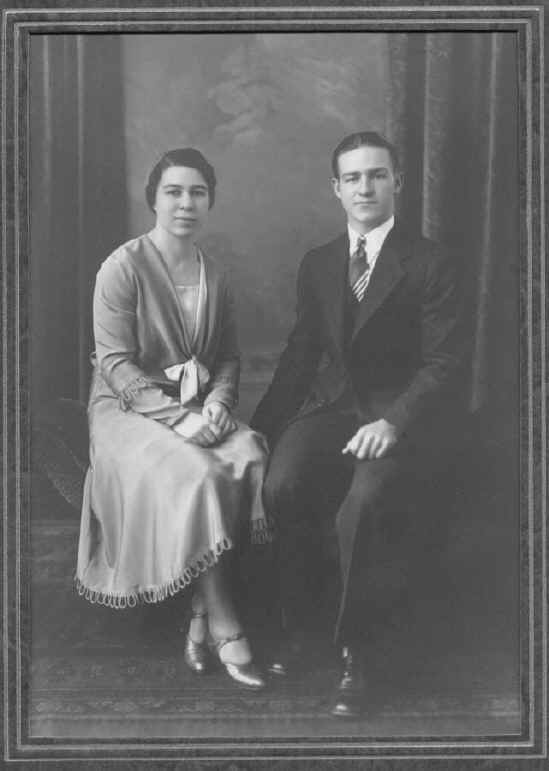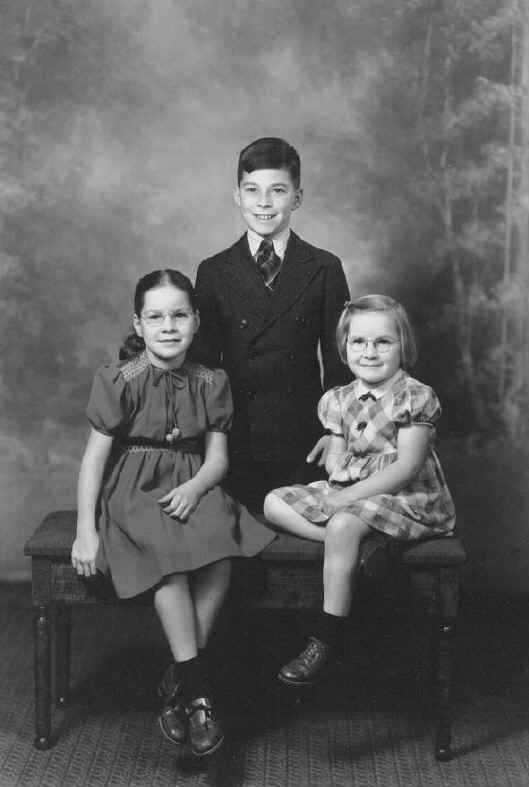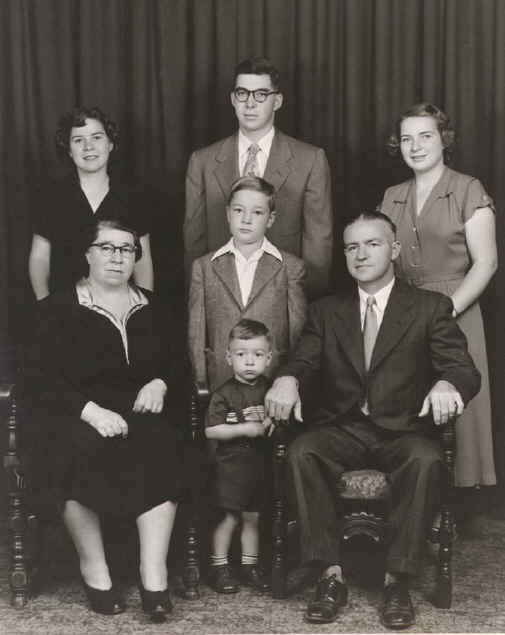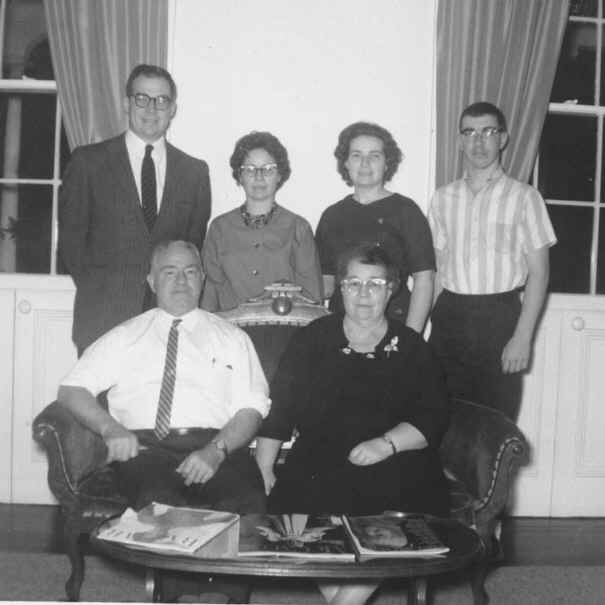

Hiram and Irene Frysinger

Their life Histories
Hiram Frysinger was born on 11 Apr 1908, the first child of George May Frysinger and Clara Belle Schaffner Frysinger. Birth was in their home in Oberlin, Swatara Township, Dauphin County, Pa. George was employed as a milk deliveryman. When Hiram was two and one-half, the family moved to the Bonny Meade Farms dairy just north of the Harrisburg-Hummelstown-Hershey highway, east of Paxtang. The spring that Hiram turned six years old, his parents bought a farm between Rutherford Road and Union Deposit Road in Lower Paxton Township, Dauphin County. They packed their things in wagons and rode through the mud to their new home.
Hiram attended the one-room Mt. Pleasant School for seven years, then graduated from Lower
Paxton Vocational High School in 1925. His favorite subjects were math and the sciences.
For a vocational project, he raised some baby chicks and was soon selling eggs to
customers on his dad’s door-to-door market route in Steelton. Hiram played baseball
and basketball, acted in school plays, and was voted the most modest in his senior class.
His parents held the dream of education for their children, and Hiram always knew he would
go to college. During his freshman year at Elizabethtown College, his classmates observed
that Hiram was studious, his hobby was chemistry, and his future was in farming.
Hiram recalled, “In the opening convocation of my sophomore year, when all of the
freshman were introduced, there was one freshman girl I thought looked rather interesting
. . .
Irene Keller Royer was born on 6 Feb 1909, the daughter of Clayton H. Royer and Susie M. Keller. Clayton was a butcher in the village of Lexington, Warwick Township, in Lancaster County. When Irene was four years old, Clayton and Susie purchased a butchering business and the family moved to Neffsville.
Irene was an only child, quiet and studious. She excelled in all her studies, and gave the
valedictory address at the “First Annual Eighth Grade Commencement of Neffsville
Consolidated School” on 5 May 1922. Irene continued at the Neffsville School
for her ninth-grade studies, then commuted to and graduated from Stevens High School, the
girls’ high school in Lancaster. She took the Classical Course, and was elected
secretary of the Honor Society. She was Vice-President of her Junior Class, played tennis,
and began debating. Her classmates quipped, “she drowned in deep
literature.” However, Irene was active in the Girl Reserves, enjoyed
camping, and helping with the cattle at her dad’s farm.
Irene entered Elizabethtown College on 3 Sep 1926. Less than three weeks later, she had
her first college date—with Hiram Frysinger. With many girlfriends and
boyfriends, college was a time of fun and foolishness as well as study and seriousness for
both Hiram and Irene. College provided opportunities for expanding horizons and developing
leadership.
Hiram pursued his interests in math and chemistry. He remembered, “A. C. Baugher was
my advisor. After my freshman year, he appointed me as his lab assistant. When he was away
taking his graduate work I had the responsibility of packing everything from the old
science lab and transferring it to the new Gibble Hall lab and setting up the
laboratory.”
Irene excelled in English and languages. She acted as “spokesman for the freshman
girls.” She resumed her interest in debating and became captain of the
women’s team. She was a class officer and leader of several campus groups. Hiram
enjoyed the intramural sports of basketball and baseball. Irene played basketball, and
“took the girls tennis championship of all classes” her sophomore year.
Hiram graduated from Elizabethtown in 1930 and accepted a teaching job at Landisburg, in
Perry County. After one year at Landisburg, Hiram obtained a position at his alma mater,
Lower Paxton High School and moved home with his parents.
Irene graduated from Elizabethtown College, magna cum laude, on 2 Jun 1930. With the
benefit of library science courses taken in summer school at Millersville State Teachers
College, Irene became certified to teach English, German, and Social Studies and “To
act as Teacher-Librarian” Irene accepted an offer to teach oral English and
have charge of the library at the Minersville High School in Schuylkill County, for
$147.03 monthly.
Minersville was inconveniently far from both home and Hiram! On 24 Dec 1930, Hiram and
Irene returned to Elizabethtown and were married by Hiram’s mentor, Rev. A. C.
Baugher. After the holidays, it was back to school in opposite directions.
After finishing the school year, they went on a honeymoon trip through New England and
Canada. They continued to live at Hiram's parents' home until their first son, Galen, was born. They then rented a home in Colonial Park for six months
before moving to an apartment in Penbrook that they rented from the president of the
school board. Hiram supplemented his teaching salary by driving a school bus. But in 1932,
as the economy worsened, he had to give up the second job and his salary was reduced.
The year 1933 was pivotal for Hiram and Irene. The Depression was in full sway, their
second child, Anne, was born, and on December 11, Hiram was called to
the free ministry in the Big Swatara Church of the Brethren. The method of selection was
for those in attendance at the council meeting to write on a slip of paper the name of the
person they considered most fitted for the responsibility. The person with a plurality of
votes was thus “called.” One more major decision was soon made which set the
pattern of life for the coming years. Hiram recalled, “In 1934, when Galen started
riding the banister of the second-floor apartment, we thought we ought to look for a
place, and that's when we moved out to Union Deposit Road to the 25-acre farm right next
to my dad's.” Hiram's father subsequently purchased all but five of the acres. On
these five acres, Hiram and the family raised laying chickens, eggs, and garden produce to
eat and to sell door-to-door in Steelton, the route maintained with his father, brother,
and the children. Hiram often commented that he used his school check to pay for the
chicken feed and the chicken money to live on.
Hiram taught at Lower Paxton High School until 1942 when he accepted an offer to teach
chemistry and physics at Hershey High School. He received a M.Ed. degree from Penn State
in 1945. He gradually shifted to teaching in the Hershey Junior College. When it closed in
1965, Hiram became Professor of Chemistry in the Harrisburg Area Junior College.
Teaching science was but one facet of Hiram's life. There was a life-long commitment to
service in the church. A “call” from the church to become a minister was heard
as a call from God, and was to be accepted. Hiram and Irene were installed into the full
ministry of the Church of the Brethren on 8 Dec 1934. Hiram never felt that preaching was
his forte. Partly because of Irene's involvement in and leadership of the Women's Debate
team at Elizabethtown College, Hiram had tried out for the Men's Debate team. He made
alternate, but remained alternate, and graduated from college with little experience in
public speaking. He said he could only preach the way he taught. (However, once a school
administrator observing his class commented that he talked too loud—he sounded like a
preacher!)
Without training in psychology or interpersonal skills, Hiram also realized his
limitations in being a “pastor” to the congregation. His confrontational style
may at times have contributed to dissension. However, being a minister provided
opportunities for Hiram to use his impressive skills in organization, planning, and
leadership. In 1940, he was ordained an elder. That year, Hiram assisted Irene in
organizing and directing the first 2-week Bible School to be held in the Hanoverdale
church. From 1943 to 1955 and from 1959 to 1970, Hiram served as elder-in-charge of the
Big Swatara congregation. He was instrumental in the 1949 remodeling of the Hanoverdale
church building. He organized a youth group and later enjoyed traveling with groups of
young people to attend National Youth Conferences. In 1960, he initiated a summer day camp
program at the Hanoverdale church.
Early mentors such as A.C. Baugher, R.W. Schlosser, and F.S. Carper had led the way to
Hiram's involvement in District church work. With his background in natural science, Hiram
was a strong supporter of the church camping program. A few hours after his son, Roy, was born in 1943, he was with a group surveying the site of the future
Camp Swatara. He served on the Camp Swatara board about 25 years and was a camp counselor
or director for about 75 weeks during those summers. His son Galen helped lay out the
nature trails surrounding the camp. His youngest son, Carl, born in
1949, was often there with him, first as a kindergartner “helping” his Dad build
the West camping area. All of the children have fond memories of being campers, and later
counselors, at Camp Swatara.
In 1943, Hiram was elected to the District Board of Christian Education and was appointed
director of Sunday School work. This involved planning four full-day Christian education
meetings each year. The Labor Day meeting was always with a mission emphasis. Hiram and
Irene would meet the guest missionary speakers at the train in Harrisburg, entertain them
in their home overnight, and take them to the meetings. Consequently, the family became
personally acquainted with many of the prominent missionaries of the Church of the
Brethren.
Hiram served 12 years on the district board of Eastern Pennsylvania and was district moderator in 1958. He was the first board chairperson of the Atlantic Northeast District and had other responsibilities on that board for seven years. Perhaps the most significant district project was the District Filmstrip Library which Hiram and Irene founded in 1946 to provide audio-visual aids for the churches. The growing library took over much of the family home! Thousands of filmstrips and audio cassettes were purchased, a comprehensive catalog was written and published periodically, and up to 10,000 items were mailed each year to churches in all 23 districts of the Church of the Brethren, from Washington to Florida.
Irene worked with the District library committee. She was a frequent speaker at
Mother’s Day events. From 1952–1957, Irene served as president of the Eastern
District Church of the Brethren Women’s Work. Her interests reached into the
community as well. She joined the local Farm Women’s group, and rose to become the
Pennsylvania State President of the Society of Farm Women from 1949–1953.
Hiram also became involved in the community. He had attended Lower Paxton Township schools
as a student for eleven years, and had taught in the high school for twelve years, and
then, beginning in 1948, he served on the township School Board for fourteen years. He
particularly enjoyed gathering information from the school administrators, analyzing the
data in terms of future needs, and interpreting these needs to the PTAs and public
officials. During his time with the board, two large high schools were built in the
rapidly developing area east of Harrisburg.
Hiram and Irene suffered an emotional blow in 1967 when their younger daughter, Faye, died of cancer. Irene’s health began to deteriorate. She was a large, heavy woman and had cholesterol levels so high the cholesterol came out in “bumps” on her limbs. When hospitalized to have some bumps removed, she incurred a persistent staphylococcus infection. She lost function in one kidney. She had heart attacks in January and February and died on 20 Mar 1971. She was only 62 years old. And Hiram had always figured he would be the one to go first.
Over the months that followed, Hiram renewed an old friendship with a college classmate of
Irene's who had been recently widowed. Hiram and Miriam Frantz Wenger
were married on 18 Sep1971. They continued operating the filmstrip library until 1982, at
which point it was turned over to his son, Roy, and his wife, Doris.
One of Hiram's last major undertakings was to provide a home for his old age! He was a
member of a study committee planning the Lebanon Valley Brethren Home, served on the
building committee, and then on the board of trustees from 1975–1981. In 1982, Hiram
and Miriam sold the family home on Union Deposit Road and moved to a duplex on the campus
of the Lebanon Valley Brethren Home, in Palmyra, Pa.
A hard-working, almost driven man, Hiram was not always easy to live with. He expected
others to work at the level of intensity he preferred. He expected things to be done
promptly and done well. Patience was never one of his virtues. The thousands of meetings
he attended over the years left little time for traditional family life. He seemed to
enjoy his children most when he was educating them. I remember him reading us the Sunday
School papers while mother prepared Sunday lunch. We played Bible quiz games on the way to
church. He took us on a wildflower search each spring. He tried to teach us the location
of the constellations in the night sky. He taught us geography as we traveled. Usually in
conjunction with attendance at the Church of the Brethren Annual Conference, each child
was taken on an extended trip around the United States at least once. Hiram had an
extensive stamp collection, and encouraged his children and grandchildren to share this
hobby.
When asked what had been the most fun in his life, Hiram hesitated a moment, then recalled
one planning committee after another. He said he guessed he'd been a workaholic. His fun
had been in his many opportunities to exercise his “vision of development.” This
phrase captures the essence of Hiram's major contribution to his church and community.
Hanoverdale Church granted him the honor of minister emeritus in 1981. On 2 Oct 1993, he
was awarded Elizabethtown College’s “Service to Humanity” award. An event
at the Lebanon Valley Brethren Home on 2 Jun 1996 honored Hiram on the 50th anniversary of
the District Filmstrip Library, and recognized Hiram’s significant contributions to
Camp Swatara and the district.
A late developing adolescent, Hiram never did grow very tall. He was about 5 feet 7
inches, and of stocky build. Slim as a young man, his middle-aged weight was about 180
pounds. He had straight dark hair and gray eyes. Due to his Frysinger genes, his hair
turned white in his early 40s. In later years, he allowed his crew cut hair to grow longer
and wore a close-cropped beard. His high blood pressure was first detected in his teenage
years, and he soon began taking medication for it. When 67, he had a serious angina attack
which required hospitalization. From then on, medications increased and he carried his
nitroglycerin pills to forestall heart attacks. In his late 70s, he began treatment for
diabetes. About the age of 80, prostate problems and recurring angina attacks resulted in
a series of hospitalizations.
Miriam had developed Parkinson's disease and her increasing disability necessitated her
moving to nursing care in April 1990. In September of 1991, she suffered a debilitating
stroke which left her paralyzed and unable to speak or eat. Miriam died on 14 Jan 1992.
Hiram continued to feel well (in-between angina attacks), and enjoyed reading, television,
and attending the Hanoverdale Church. However, the angina attacks became more frequent and
more severe. Successful bypass surgery helped mitigate the problem, but eventually Hiram
decided to move to the personal care wing of the Lebanon Valley Brethren Home he had
helped build. The man who always liked to be in control was distressed when the decision
to move into nursing care was made for him. He learned patience as his health deteriorated
further. Hiram died on 20 Aug 1997, at the age of 89 years, four months, and nine days.
Hiram J. Frysinger and his wife Irene K. Royer are
buried in the Church of the
Brethren Cemetery, Hanoverdale, Pa.
A more detailed anecdotal-pictorial account of the lives of Hiram and Irene Frysinger is here.
The Torch, Yearbook of Lower Paxton Vocational High School, 1925, p. 23.
The Elizabethtown College, Etonian, 1926, p. 74.
Commencement Program. She spoke on “Emblems.”
Vidette Annual, Yearbook of Stevens High School, 1926, p. 49.
Girl Reserves was the “national movement of the Young Women’s Christian Association” for girls twelve to
eighteen.12-18. Slogan: “To face life squarely.” Purpose: “To find and give the best.”
Irene began keeping a scrapbook in college and maintained it until late in life. It has provided clues and/or
verification for many of her experiences.
Etonian, 1927 Yearbook of Elizabethtown College. p. 68.
Etonian, 1928 Yearbook of Elizabethtown College. p. 72.
Commonwealth of Pennsylvania, Department of Public Instruction, College Certificate, dated 9 Jul 1930, Library
Science added 2 Sep 1930.
Contract with Minersville School district, dated 14 May 1930.
Colonial Park and Penbrook are eastern suburbs of Harrisburg.
Text by my sister Anne
Irene's grave
Funeral Notice
Obituary
The graves in 1999 as his brother, Harry M. Frysinger, is about to be buried. (Hiram and Irene Frysinger, in front, George and Clara Frysinger, behind)
The Family
Galen and Anne

Galen, Anne and Faye

Back Left to Right: Anne, Galen and Faye
Middle: Roy
Front Left to Right Irene, Carl and Hiram

Family group 1963
(click to go to first time cited in text above)
Anne Louise Frysinger
Carl Eugene Frysinger
Galen Royer Frysinger
Irene Keller Royer Frysinger
Roy Donald Frysinger
Susie May Keller Royer
![]()
Return to Galen's Father's page
Return to Galen's Mothers page
Return to Galen's "Life and Interests"
![]()